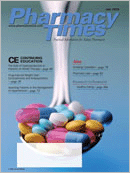Publication
Article
Pharmacy Times
ASTHMA WATCH
Safety Concerns May Initiate Poor Breathing
US high school students are more susceptible to asthma attacks if they were victims of violent crimes, according to a study of 1943 patients with asthma. Of the participants who had been victimized in the past year, 45% were more likely to report an asthma episode in this period, compared with participants who were not victims.
For this study, victimization was defined as having been threatened or injured with a weapon or club on school property; having had something stolen or deliberately damaged on school property; or having an injury that needed treatment in the past year. The study's findings, reported in the American Journal of Public Health (May 2006), validated previous studies that have connected exposure to violence and asthma illness in patients who reside in inner cities.
Low Antioxidant Intake Linked with Asthma
Vitamin C, manganese, and fruit intake is lower among individuals with symptomatic asthma, compared with healthy individuals. While several antioxidant nutrients have been associated with a lower asthma risk, researchers are unsure whether each of these nutrients influences reducing the risk or if the nutrients represent an overall healthier lifestyle.
For the study, 1030 patients (515 with asthma and 515 controls) reported their food intake for 1 week. The patients with asthma ate an average of 132.1 g of fruit daily, compared with 149.1 g for the healthy patients. The participants who consumed at least 46.3 g of citrus daily had about half the risk of experiencing asthma symptoms, compared with participants who ate no citrus. The reduced intake of both vitamin C and manganese was associated with an elevated risk of asthma. Patients with symptomatic asthma, however, had substantially lower levels of plasma vitamin C, compared with the healthy patients.
The researchers noted in Thorax (May 2006) that the results did not support the view that overall healthy lifestyles play a part in asthma risk. Both asthma patients and healthy controls ate the same amounts of calories and fat and showed similar levels of physical activity, education, and odds of having smoked.
Pilot Program Is Expanded
The Asthma Intervention Program will be expanded to 5000 patients. The national pilot program is studying the ability of pharmacists to identify and positively influence the health outcomes in patients with uncontrolled asthma.
Pharmacists use the Asthma Control Test (ACT), a 5- question assessment tool, to evaluate how well the patient's asthma is currently being monitored. Patients will complete 2 ACT surveys. The scores will be shared with the patient's physician, and each patient's asthma medication history will be captured. Patient data will be entered electronically into a Health Insurance Portability and Accountability Act-compliant database.
The program is a joint research study by the National Community Pharmacists Association, Medical Care and Outcomes LLC, and sponsor GlaxoSmithKline. For more information, visit www.pharmacistelink.com/asthma.
Heat Treatment Can Help
A 30-minute bronchial thermoplasty therapy improved patients' with asthma lung capacity, airway responsiveness, and symptom-free days, according to the findings of a study reported in the American Journal of Respiratory and Critical Care Medicine (May 1, 2006).
The technique involves the application of radio frequency thermal energy directly to the airway through a bronchoscope. The energy heats the airway tissue to about 149?F. The temperature is hot enough to reduce airway smooth muscle mass but cool enough to avoid tissue destruction and scarring. During the 2-year study, 16 participants (6 men and 10 women) received 3 separate treatment sessions at the start of the study. The sessions were needed for each patient in order to treat all accessible airways of both lungs.
Over the first 12 weeks after treatment, the participants demonstrated a major improvement in the number of symptom-free days and in the morning and evening airway peak flow. The researchers will follow the patients for 5 years in order to determine any long-term safety concerns associated with therapy.
Education Benefits All
Asthma education is important, even for children without the condition. Reporting in the European Respiratory Journal (May 2006), the researchers found children with asthma fared better in schools that offered asthma education programs to all students. The study included 24 elementary schools that were randomly assigned to offer either an asthma education program or a general workshop on the respiratory system. A nurse led the programs for staff and students at education sites.
During the program, students were taught "what it feels like"to have asthma and how to help a friend who is coughing or having difficulty breathing. A year later, the children with asthma in the intervention schools had better self-esteem and needed less medication to prevent attacks. The students also reported their condition less of an obstacle to being physically active.
Different results were seen in the schools that did not participate in the program. The children in the comparison schools did not show parallel improvements. Plus, the girls newly diagnosed with asthma during the study showed a decline in their self-esteem.







